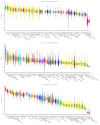Pathomechanisms of Blood-Brain Barrier Disruption in ALS
- PMID: 31380411
- PMCID: PMC6652091
- DOI: 10.1155/2019/2537698
Pathomechanisms of Blood-Brain Barrier Disruption in ALS
Abstract
The blood-brain barrier (BBB) and the blood-spinal cord barrier (BSCB) are responsible for controlling the microenvironment within neural tissues in humans. These barriers are fundamental to all neurological processes as they provide the extreme nutritional demands of neural tissue, remove wastes, and maintain immune privileged status. Being a semipermeable membrane, both the BBB and BSCB allow the diffusion of certain molecules, whilst restricting others. In amyotrophic lateral sclerosis (ALS) and other neurodegenerative diseases, these barriers become hyperpermeable, allowing a wider variety of molecules to pass through leading to more severe and more rapidly progressing disease. The intention of this review is to discuss evidence that BBB hyperpermeability is potentially a disease driving feature in ALS and other neurodegenerative diseases. The various biochemical, physiological, and genomic factors that can influence BBB permeability in ALS and other neurodegenerative diseases are also discussed, in addition to novel therapeutic strategies centred upon the BBB.
Figures


Similar articles
-
Altered blood-brain barrier and blood-spinal cord barrier dynamics in amyotrophic lateral sclerosis: Impact on medication efficacy and safety.Br J Pharmacol. 2022 Jun;179(11):2577-2588. doi: 10.1111/bph.15802. Epub 2022 Feb 7. Br J Pharmacol. 2022. PMID: 35048358 Review.
-
Amyotrophic lateral sclerosis: a neurovascular disease.Brain Res. 2011 Jun 29;1398:113-25. doi: 10.1016/j.brainres.2011.04.049. Epub 2011 May 12. Brain Res. 2011. PMID: 21632035 Review.
-
Neurovascular aspects of amyotrophic lateral sclerosis.Int Rev Neurobiol. 2012;102:91-106. doi: 10.1016/B978-0-12-386986-9.00004-1. Int Rev Neurobiol. 2012. PMID: 22748827 Review.
-
Evidence of compromised blood-spinal cord barrier in early and late symptomatic SOD1 mice modeling ALS.PLoS One. 2007 Nov 21;2(11):e1205. doi: 10.1371/journal.pone.0001205. PLoS One. 2007. PMID: 18030339 Free PMC article.
-
Taking Advantages of Blood-Brain or Spinal Cord Barrier Alterations or Restoring Them to Optimize Therapy in ALS?J Pers Med. 2022 Jun 29;12(7):1071. doi: 10.3390/jpm12071071. J Pers Med. 2022. PMID: 35887567 Free PMC article. Review.
Cited by
-
Brain-body mechanisms contribute to sexual dimorphism in amyotrophic lateral sclerosis.Nat Rev Neurol. 2024 Aug;20(8):475-494. doi: 10.1038/s41582-024-00991-7. Epub 2024 Jul 4. Nat Rev Neurol. 2024. PMID: 38965379 Review.
-
Pathomechanistic Networks of Motor System Injury in Amyotrophic Lateral Sclerosis.Curr Neuropharmacol. 2024;22(11):1778-1806. doi: 10.2174/1570159X21666230824091601. Curr Neuropharmacol. 2024. PMID: 37622689 Free PMC article. Review.
-
In-vitro and in-vivo assessment of the bactericidal potential of peracetic acid and hydrogen peroxide disinfectants against A. hydrophila infection in Nile tilapia and their effect on water quality indices and fish stress biomarkers.Sci Rep. 2024 Oct 28;14(1):25715. doi: 10.1038/s41598-024-76036-2. Sci Rep. 2024. PMID: 39468161 Free PMC article.
-
Blood-CNS barrier dysfunction in amyotrophic lateral sclerosis: Proposed mechanisms and clinical implications.J Cereb Blood Flow Metab. 2023 May;43(5):642-654. doi: 10.1177/0271678X231153281. Epub 2023 Jan 26. J Cereb Blood Flow Metab. 2023. PMID: 36704819 Free PMC article. Review.
-
C9ORF72 patient-derived endothelial cells drive blood-brain barrier disruption and contribute to neurotoxicity.Fluids Barriers CNS. 2024 Apr 11;21(1):34. doi: 10.1186/s12987-024-00528-6. Fluids Barriers CNS. 2024. PMID: 38605366 Free PMC article.
References
Publication types
LinkOut - more resources
Full Text Sources
Other Literature Sources
Miscellaneous

